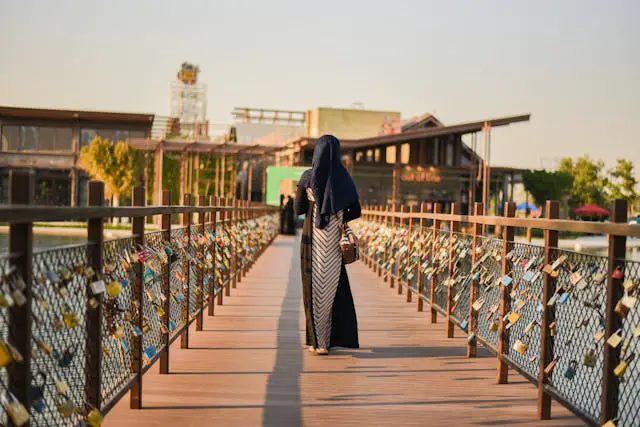
Islam is one of the fastest-growing religions in America, reflecting a rich and diverse history.
The journey of Islam in the United States is marked by resilience, contributions, and a continuous fight against misconceptions.
This blog post aims to provide a detailed look at the rise of Islam in America, from its early days to its present and future.
The Early Years
Early Muslim Communities
The story of Muslims in America starts with the arrival of enslaved Africans.
Many of these individuals were Muslims, with estimates suggesting that between 10-15% of the Africans brought to America as slaves practiced Islam.
Due to the harsh and oppressive conditions of slavery, these early Muslims often had to practice their faith in secret.
Despite the challenges, they held on to their beliefs and traditions as much as possible, passing them down through generations.
- Read also: Chronicles of Faith: Tracing the Islamic Caliphates Timeline
- Read also: A Historical Journey: The Spread of Christianity in the Middle Ages
Islam in the African American community
In the early 20th century, Islam started to gain more prominence within African American communities.
The Nation of Islam, founded in 1930, played a crucial role in this resurgence.
Leaders like Elijah Muhammad and Malcolm X were key figures in this movement.
Elijah Muhammad led the Nation of Islam and focused on black empowerment and self-reliance.
His leadership helped the organization grow and become a powerful voice for civil rights.
Malcolm X, a prominent member of the Nation of Islam, brought further attention to the faith.
His speeches and writings highlighted the struggles of African Americans and promoted Islam as a path to empowerment and justice.
His journey and pilgrimage to Mecca showcased the inclusive nature of Islam, broadening its appeal.

Challenges and Discrimination
Islamophobia and backlash
Muslims in America have faced significant discrimination, especially following events like the 9/11 attacks.
The aftermath of 9/11 saw a surge in hate crimes against Muslims, with incidents increasing by 500% in the year following the attacks.
This wave of Islamophobia created an environment of fear and prejudice.
However, the Muslim community has demonstrated remarkable resilience in the face of these challenges.
Building resilience
In response to discrimination, Muslims have built strong community networks and engaged in interfaith dialogue to foster understanding and support.
Organizations like the Council on American-Islamic Relations (CAIR) have played a crucial role in this effort.
CAIR advocates for the rights of Muslims, providing legal support and standing up against injustice.
By building these networks and alliances, the Muslim community has strengthened its foundation and created a sense of solidarity.
Legal battles and advocacy
Muslim Americans have been active in legal advocacy, fighting against discriminatory policies and practices.
A notable example is the opposition to the “Muslim Ban” in 2017.
This policy, which restricted travel from several predominantly Muslim countries, sparked widespread protests and legal challenges.
The determined efforts of activists and legal experts eventually led to the lifting of the ban for some countries, highlighting the power of collective action and legal advocacy.

The Modern Muslim American Experience
Contributions to American society
Muslims in America make significant contributions across various sectors.
They are doctors, teachers, business owners, and more, playing essential roles in healthcare, education, and the economy.
With over 3,000 mosques spread across the United States, Muslims are active participants in civic life, engaging in community service, charity work, and local governance.
Their involvement enriches American society and helps build stronger, more connected communities.
Muslim youth
The new generation of Muslim Americans is thriving and more integrated into broader society than ever before.
These young people are excelling in diverse fields such as science, arts, sports, and politics, breaking down stereotypes and showcasing the diversity and talent within the Muslim community.
They are not only achieving personal success but also contributing to the cultural and intellectual richness of the country.
Interfaith relations
Efforts to promote interfaith understanding have also grown, with many Muslims working alongside other religious communities.
These initiatives aim to foster dialogue, mutual respect, and cooperation.
By participating in interfaith events and projects, Muslims help combat ignorance and prejudice, promoting a more inclusive and harmonious society.
These collaborations are vital in building bridges between different faith groups and enhancing social cohesion.

Common Misconceptions About Islam in America
Myth vs reality
One of the biggest misconceptions is that Islam is a foreign religion, not truly part of American culture.
In reality, Islam has been part of America’s religious landscape for centuries, starting with the arrival of enslaved Africans, many of whom were Muslims.
Another common myth is that all Muslims are Arabs.
In truth, Muslims in America come from a wide variety of backgrounds, including African, South Asian, Middle Eastern, and many others.
This diversity enriches the American Muslim community and reflects the broader multicultural makeup of the country.
Media representation
The media often portrays Islam in a negative light, focusing on extremism and violence.
These portrayals are not reflective of the vast majority of peaceful and law-abiding Muslim Americans.
Such biased representation can lead to misunderstandings and prejudice.
However, efforts are being made to change this narrative.
More accurate and positive portrayals of Muslims in media and entertainment help to show the true diversity and contributions of the Muslim community.
Education and awareness
Education plays a crucial role in dispelling myths about Islam.
Many Muslim organizations are working hard to provide accurate information about Islam and its teachings.
They organize seminars, workshops, and community outreach programs to educate people about the true nature of Islam.
By promoting understanding and awareness, these efforts help to break down stereotypes and build a more informed and accepting society.
The Future of Islam in America
Demographics and growth
Islam is expected to become the second-largest religion in the United States by 2040.
This growth is driven by a young and diverse Muslim population.
Young Muslims are not only maintaining their faith but also integrating into American society in various ways, contributing to its cultural, economic, and social fabric.
This youthful demographic ensures a vibrant future for Islam in America, marked by continued growth and greater visibility.
Political engagement
Muslim Americans are becoming more politically active. Increasing numbers of Muslims are running for public office, participating in civic activities, and advocating for their communities.
This political engagement is vital for ensuring that the rights and interests of the Muslim community are represented and protected.
As Muslim Americans take on more prominent roles in politics, they help shape policies and decisions that impact not only their community but the broader society as well.
Challenges and opportunities
Despite facing challenges like discrimination and Islamophobia, the Muslim community has numerous opportunities for growth and positive impact.
Education and advocacy are key to overcoming these challenges.
By continuing to engage with broader society, educate others about Islam, and advocate for justice and equality, Muslims in America can contribute to a more inclusive and understanding society.

- Read also: A Look Back in Time: The Most Impactful American History Events
- Read also: Who Discovered America? The History That You Probably Haven’t Heard
Conclusion
The rise of Islam in America is a story of resilience, contribution, and hope.
Despite facing significant challenges, the Muslim community continues to thrive and make meaningful contributions to American society.
By understanding this journey, we can appreciate the rich diversity that Islam brings to the American tapestry.


